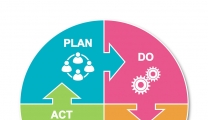The Importance of a Successful HCM Implementation
Human Capital Management (HCM) systems play a crucial role in enabling organizations to manage employee data, and many businesses choose to adopt multiple integrated systems. As technology evolves and new HCM companies emerge, companies have a wide range of options available to them. These companies offer products with additional features and guide businesses through the implementation process. To maximize the benefits of an HCM system, it is important to have a good understanding of how to effectively utilize employee data and prepare for implementation to ensure success on the first attempt.
A company may have various motivations to implement a new HCM system, and one of the primary reasons is to have all HR processes consolidated in one system. This consolidation results in better reporting capabilities and facilitates employee development. Moreover, the new system provides employees with self-service options, reducing the burden on HR staff and enabling them to focus on more critical functions.

Importance of a Successful Human Capital Management Implementation
8 Steps for a Successful HCM Implementation
An HCM system streamlines HR processes, which enables HR staff to focus on strategic initiatives that drive business success. However, implementing an HCM system can be a complex and challenging process. To help organizations ensure a successful HCM implementation, here are eight key steps to follow:
Assemble an Implementation Project Team
To ensure a successful Human Capital Management, it is recommended to examine the roles and responsibilities outlined in the HCM implementation services agreement, if available. Identify internal resources required to meet the project objectives, such as domain experts, team members with specific skills like benefit or compensation, colleagues who understand current people management processes, and a technical resource familiar with the organization's technology infrastructure.
Before starting work with project consultants, convene the team to discuss and agree on each member's project role and assigned responsibilities. Confirm that every member understands and accepts their responsibilities. If necessary, negotiate project responsibilities and realign the team to ensure a successful implementation.

Project Team for Human Capital Management
Set Goals, Outcomes, and Metrics
Collaborate with the implementation team, project sponsor(s), and executives to determine a practical implementation and project plan. Draw upon the experience of team members who have previously implemented HR and/or payroll software. Implementing too much new technology within a short time frame can lead to added stress and risk for the software implementation project, which can ultimately reduce user adoption.
Therefore, it is advisable to work with the implementation consultants to plan a realistic approach to deploying the new HCM solution in stages. This can reduce stress, minimize risks, and increase user acceptance. Expecting 100% user adoption of the new HCM system is unrealistic, so it is crucial to adjust project expectations and outcomes to achieve and celebrate success.
Besides, to prevent misunderstandings and disruptions, verify executive expectations and define a clear vision for a successful implementation. Ensure all team members understand desired outcomes and expectations from the onset to establish clear success milestones regardless of their tasks. Clearly communicating project outcomes and individual roles' impact is crucial for project success.

Goals of Human Capital Management
List All HCM Project Requirements
Encouraging team members to prioritize requirements creates individual responsibility and ownership. Holding a meeting to prioritize requirements before starting the project can lead to an accurate plan and faster implementation. Make a list of functional and technical requirements for the HCM solution, implementation, and vendor, then assign each one a priority: "Must-Have", "Important", or "Nice-to-Have". Most requirements are "Important", meaning the outcome is significant, but there is flexibility in achieving it. "Must-Have" requirements are rare.

HCM Project Requirements List
Create a Change Management Strategy for Your Workforce
It's important to embrace change and advocate for the new people management system. Ask why certain requirements or processes are necessary, and if there's no clear answer, ask how they can be improved. Define the change management process with the team and communicate it to end-users. It's normal to feel anxious, but encourage openness to new ways of managing people and processes. This mindset will build trust within the team.
Migrate Your HCM Data
Before the project kick-off, it's important to locate and prioritize your people-related data and decide what needs to be converted to the new HCM system. You should also discuss whether the data needs to be cleaned up or updated, and identify the right resources responsible for this task. Cleaning up the data now will ensure greater consistency and reliability, and create more reliable and attractive information. The implementation consultants will provide details on the data conversion process and preferred formats.

Migrate Your HCM Data
Onboarding and Training
We highly recommend that you schedule sufficient time for your project team to receive comprehensive training and develop the skills and knowledge needed to become self-sufficient. Whenever feasible, opt for face-to-face application training rather than remote training. Based on our extensive experience in Human Capital Management implementation, we have found that face-to-face training is more effective and leads to better knowledge retention by trainees. Plan how to create and distribute internal processes and system training documentation during the project and to new hires in the future.
Onboarding and training will be critical for the success of the implementation and future user adoption. Documentation for infrequent events like open enrollment and performance evaluations can serve as a valuable resource and a quick refresher, reducing support calls, consulting fees, and saving time and energy.

Training and develop the skills and knowledge needed to your project team
Launch Beta Tests with Small Teams
Launch beta tests with small teams to identify any technical issues and to ensure that the system is working as intended. This will also provide an opportunity to make any necessary changes before rolling out the HCM system to the entire organization.
Go Live and Monitor for Technical Issues
After the beta tests, go live with the HCM system and monitor for any technical issues. Ensure that you have a support team in place to address any issues that arise. This is the moment when the new system becomes operational, and all the hard work of planning and preparing for the implementation comes together. However, this is also the time when unexpected technical issues may arise.
Therefore, it is essential to have a solid plan in place for monitoring the system closely during the Go Live period. This plan should include having a dedicated support team ready to handle any issues that arise, and establishing clear communication channels to quickly address any technical problems that may occur. By being proactive and monitoring the system closely, any issues can be addressed promptly, and the Human Capital Management systems can be a success.

Go Live and Monitor for Technical Issues
In conclusion, a successful HCM implementation is critical for organizations that want to streamline HR processes and focus on strategic initiatives that drive business success. Hope this Vindoo blog has provided you with valuable insights and practical strategies for effective Human Capital Management systems.












Replies to This Discussion